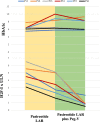Glucose metabolism outcomes in acromegaly patients on treatment with pasireotide-LAR or pasireotide-LAR plus Pegvisomant
- PMID: 33907985
- PMCID: PMC8325668
- DOI: 10.1007/s12020-021-02711-3
Glucose metabolism outcomes in acromegaly patients on treatment with pasireotide-LAR or pasireotide-LAR plus Pegvisomant
Abstract
Introduction: Disorders of glucose metabolism are a serious acromegaly comorbidity and may be differently impacted by medical treatments of acromegaly. In this retrospective longitudinal multicenter study, we investigated the outcome of glucose metabolism and its predictors in patients treated with Pasireotide LAR (PAS-LAR) alone or in combination with Pegvisomant (PAS-LAR + Peg-V).
Subjects and methods: Acromegaly patients treated continously with PAS-LAR or PAS-LAR + Peg-V for at least 6 months.
Results: Forty patients (25 females, 15 males) were enrolled. At last visit, 27/40 patients (67.5%) reached biochemical control of acromegaly. Overall, glucose metabolism improved in 3 (all in PAS-LAR + Peg-V; 7.5%), worsened in 26 (65%) and remained unchanged in 11 patients (27.5%). Glucose metabolism worsened in 25 patients (73.5%) treated with PAS-LAR and in a single patient (16.7%) treated with PAS-LAR + Peg-V (p < 0.001). Among patients treated with Pas-LAR alone, GH at baseline was higher in those with worsening of glucose metabolism (p = 0.04) as compared to those with stable glucose status. A significantly higher reduction of HbA1c was observed in patients treated with PAS-LAR + Peg-V, as compared with those treated with PAS-LAR alone (p = 0.005).
Conclusions: Our data confirmed that glucose metabolism in patients treated with PAS-LAR is often worsened, and may be predicted by entity of baseline GH hypersecretion and by the dose of PAS-LAR. Moreover, our data, although limited by small numbers, may suggest that the combination treatment PAS-LAR + Peg-V can improve glucose homeostasis in selected patients.
Keywords: Diabetes; Glucose intolerance; Growth hormone receptor antagonist; Impaired fasting glucose; Impaired glucose tolerance; Somatostatin analogues.
© 2021. The Author(s).
Conflict of interest statement
MF reports serving as an investigator with research grants to OHSU for Crinetics, Chiasma, Ionis, Novartis, Recordati; and serving as an occasional consultant to Crinetics, Chiasma, Ipsen, Novartis, Pfizer, Recordati. ORCID: 0000-0001-9284-6289, AG: Research Grants from Ipsen, Novartis and Pfizer. Consultant for Genevant and Ipsen. The other authors have nothing to disclose.
Figures




Similar articles
-
Efficacy and Safety of Switching to Pasireotide in Patients With Acromegaly Controlled With Pegvisomant and First-Generation Somatostatin Analogues (PAPE Study).J Clin Endocrinol Metab. 2018 Feb 1;103(2):586-595. doi: 10.1210/jc.2017-02017. J Clin Endocrinol Metab. 2018. PMID: 29155991 Clinical Trial.
-
Efficacy and Safety of switching to Pasireotide in Acromegaly Patients controlled with Pegvisomant and Somatostatin Analogues: PAPE extension study.Eur J Endocrinol. 2018 Oct 12;179(5):269-277. doi: 10.1530/EJE-18-0353. Eur J Endocrinol. 2018. PMID: 30076159
-
The Effect of 6 Months' Treatment With Pasireotide LAR on Glucose Metabolism in Patients With Resistant Acromegaly in Real-World Clinical Settings.Front Endocrinol (Lausanne). 2021 Mar 10;12:633944. doi: 10.3389/fendo.2021.633944. eCollection 2021. Front Endocrinol (Lausanne). 2021. PMID: 33776927 Free PMC article.
-
Pasireotide: a novel treatment for patients with acromegaly.Drug Des Devel Ther. 2016 Jan 11;10:227-39. doi: 10.2147/DDDT.S77999. eCollection 2016. Drug Des Devel Ther. 2016. PMID: 26811671 Free PMC article. Review.
-
How to Position Pasireotide LAR Treatment in Acromegaly.J Clin Endocrinol Metab. 2019 Jun 1;104(6):1978-1988. doi: 10.1210/jc.2018-01979. J Clin Endocrinol Metab. 2019. PMID: 30608534 Review.
Cited by
-
Clinical Biology of the Pituitary Adenoma.Endocr Rev. 2022 Nov 25;43(6):1003-1037. doi: 10.1210/endrev/bnac010. Endocr Rev. 2022. PMID: 35395078 Free PMC article. Review.
-
Medical treatment of functional pituitary adenomas, trials and tribulations.J Neurooncol. 2024 Jun;168(2):197-213. doi: 10.1007/s11060-024-04670-x. Epub 2024 May 18. J Neurooncol. 2024. PMID: 38760632 Review.
-
Management of pasireotide-induced hyperglycemia in patients with acromegaly: An experts' consensus statement.Front Endocrinol (Lausanne). 2024 Feb 9;15:1348990. doi: 10.3389/fendo.2024.1348990. eCollection 2024. Front Endocrinol (Lausanne). 2024. PMID: 38405148 Free PMC article.
-
Combination of pasireotide and octreotide: effects on GH and IGF-I secretion and glucose metabolism in healthy volunteers.Endocrine. 2022 Feb;75(2):537-548. doi: 10.1007/s12020-021-02908-6. Epub 2021 Nov 6. Endocrine. 2022. PMID: 34741720
-
Acromegaly and Bone: An Update.Endocrinol Metab (Seoul). 2023 Dec;38(6):655-666. doi: 10.3803/EnM.2023.601. Epub 2023 Dec 22. Endocrinol Metab (Seoul). 2023. PMID: 38164073 Free PMC article. Review.
References
-
- Melmed, S. Pituitary-tumor endocrinopathies. N Engl J Med. (2020). 10.1056/NEJMra1810772 - PubMed
-
- Gadelha, M.R., Kasuki, L., Lim, D.S.T., Fleseriu M. Systemic complications of acromegaly and the impact of the current treatment landscape: an update. Endocr Rev. (2019). 10.1210/er.2018-00115 - PubMed
-
- Solari D, Pivonello R, Caggiano C, Guadagno E, Chiaramonte C, Miccoli G, Cavallo LM, Del Basso De Caro M, Colao A, Cappabianca P. Pituitary adenomas: what are the key features? what are the current treatments? where is the future taking us? World Neurosurg. 2019;127:695–709. doi: 10.1016/j.wneu.2019.03.049. - DOI - PubMed
-
- Mestron A, Webb SM, Astorga R, Benito P, Catala M, Gaztambide S, Gomez J, Halperin I, Morante TM, Moreno B, Obiols G, de Pablos P, Paramo C, Pico A, Torres E, Varela C, Vazquez JA, Zamora J, Albareda M, Gilabert M. Epidemiology, clinical characteristics, outcome, morbidity and mortality in acromegaly based on the Spanish Acromegaly Registry (Registro Español de Acromegalia, REA) Eur J Endocrinol. 2004;151:439–46. doi: 10.1530/eje.0.1510439. - DOI - PubMed
Publication types
MeSH terms
Substances
LinkOut - more resources
Full Text Sources
Other Literature Sources
Miscellaneous

